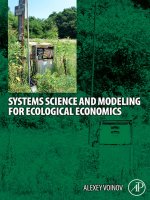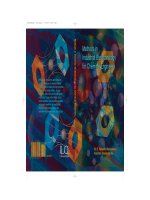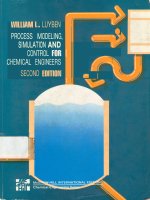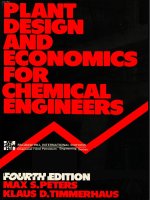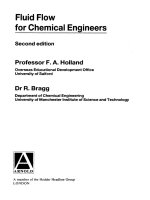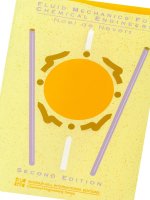rice applied mathematics and modeling for chemical engineers
Bạn đang xem bản rút gọn của tài liệu. Xem và tải ngay bản đầy đủ của tài liệu tại đây (22.42 MB, 731 trang )
Applied Mathematics
and Modeling
for
Chemical Engineers
Richard
G.
Rice
Louisiana State University
Duong
D. Do
University
of
Queensland
St. Lucia, Queensland, Australia
John Wiley
&
Sons,
Inc.
New York • Chichester • Brisbane • Toronto • Singapore
Acquisitions Editor Cliff Robichaud
Marketing Manager Susan J. Elbe
Senior Production Editor Savoula Amanatidis
Designer Pedro A. Noa
Cover Designer Ben Arrington
Manufacturing Manager Lori Bulwin
Illustration Coordinator Eugene P. Aiello
This book was typeset in Times Roman by Science Typographers, Inc. and printed and bound
by Hamilton Printing Company. The cover was printed by Phoenix Color Corp.
Recognizing the importance of preserving what has been written, it is a policy of
John Wiley & Sons, Inc. to have books of enduring value published in the United States
printed on acid-free paper, and we exert our best efforts to that end.
Copyright © 1995 by John Wiley & Sons, Inc.
All rights reserved. Published simultaneously in Canada.
Reproduction or translation of any part of this work beyond that permitted by Sections 107
and 108 of the 1976 United States Copyright Act without the permission of the copyright owner
is unlawful. Requests for permission or further information should be addressed to the Permissions
Department, John Wiley & Sons, Inc.
Library of
Congress
Cataloging-in-Publication Data
Rice,
Richard G.
Applied mathematics and modeling for chemical engineers / Richard
G. Rice. Duong D. Do.
p.
cm.—(Wiley series in chemical engineering)
Includes bibliographical references and index.
ISBN 0-471-30377-1
1.
Differential equations. 2. Chemical processes—Mathematical
models. 3. Chemical engineering—Mathematics. I. Duong, D. Do.
II.
Title. III. Series.
QA371.R37 1994
660'.2842'015118—dc20 94-5245
CIP
Printed in the United States of America.
10 9 8 7 6 5
To Judy,
Todd
y
Andrea, and William,
for making it all
worthwhile,
RGR
To An and Binh, for making
my life full
DDD
The revolution created in 1960 by the publication and widespread adoption
of the textbook Transport Phenomena by Bird et al. ushered in a new era for
chemical engineering. This book has nurtured several generations on the
importance of problem formulation by elementary differential balances. Model-
ing (or idealization) of processes has now become standard operating proce-
dure,
but, unfortunately, the sophistication of the modeling exercise has not
been matched by textbooks on the solution of such models in quantitative
mathematical terms. Moreover, the widespread availability of computer soft-
ware packages has weakened the generational skills in classical analysis.
The purpose of this book is to attempt to bridge the gap between classical
analysis and modern applications. Thus, emphasis is directed in Chapter 1 to
the proper representation of a physicochemical situation into correct mathemat-
ical language. It is important to recognize that if a problem is incorrectly posed
in the first instance, then any solution will do. The thought process of "idealiz-
ing," or approximating an actual situation, is now commonly called "modeling."
Such models of natural and man-made processes can only be fully accepted if
they fit the reality of experiment. We try to give emphasis to this well-known
truth by selecting literature examples, which sustain experimental verification.
Following the model building stage, we introduce classical methods in Chap-
ters 2 and 3 for solving ordinary differential equations (ODE), adding new
material in Chapter 6 on approximate solution methods, which include pertur-
bation techniques and elementary numerical solutions. This seems altogether
appropriate, since most models are approximate in the first instance. Finally,
because of the propensity of staged processing in chemical engineering, we
introduce analytical methods to deal with important classes of finite-difference
equations in Chapter 5.
In Chapters 7 to 12 we deal with numerical solution methods, and partial
differential equations (PDE) are presented. Classical techniques, such as combi-
nation of variables and separation of variables, are covered in detail. This is
followed by Chapter 11 on PDE transform methods, culminating in the general-
ized Sturm-Liouville transform. This allows sets of PDEs to be solved as
handily as algebraic sets. Approximate and numerical methods close out the
treatment of PDEs in Chapter 12.
Preface
This book is designed for teaching. It meets the needs of a modern under-
graduate curriculum, but it can also be used for first year graduate students.
The homework problems are ranked by numerical subscript or an asterisk.
Thus,
subscript 1 denotes mainly computational problems, whereas subscripts 2
and 3 require more synthesis and analysis. Problems with an asterisk are the
most difficult and are suited for graduate students. Chapters 1 through 6
comprise a suitable package for a one-semester, junior level course (3 credit
hours).
Chapters 7 to 12 can be taught as a one-semester course for advanced
senior or graduate level students.
Academics find increasingly less time to write textbooks, owing to demands
on the research front. RGR is most grateful for the generous support from
the faculty of the Technical University of Denmark (Lyngby), notably Aa.
Fredenslund and K. Ostergaard, for their efforts in making sabbatical leave
there in 1991 so successful, and extends a special note of thanks to M.
Michelson for his thoughtful reviews of the manuscript and for critical discus-
sions on the subject matter. He also acknowledges the influence of colleagues
at all the universities where he took residence for short and lengthy periods
including: University of Calgary, Canada; University of Queensland, Australia;
University of Missouri, Columbia; University of Wisconsin, Madison; and of
course Louisiana State University, Baton Rouge.
Richard G. Rice
Louisiana State University
September 1994
Duong D. Do
University of Queensland
September 1994
ix
This page has been reformatted by Knovel to provide easier navigation.
Contents
Preface vii
1. Formulation of Physicochemical Problems 3
1.1 Introduction 3
1.2 Illustration of the Formulation Process (Cooling of Fluids) 4
1.3 Combining Rate and Equilibrium Concepts (Packed Bed
Adsorber) 10
1.4 Boundary Conditions and Sign Conventions 13
1.5 Summary of the Model Building Process 16
1.6 Model Hierarchy and Its Importance in Analysis 17
1.7 References 28
1.8 Problems 28
2. Solution Techniques for Models Yielding Ordinary
Differential Equations (ODE) 37
2.1 Geometric Basis and Functionality 37
2.2 Classification of ODE 39
2.3 First Order Equations 39
2.3.1 Exact Solutions 41
2.3.2 Equations Composed of Homogeneous Functions 43
2.3.3 Bernoulli's Equation 45
2.3.4 Riccati's Equation 45
2.3.5 Linear Coefficients 49
2.3.6 First Order Equations of Second Degree 50
2.4 Solution Methods for Second Order Nonlinear Equations 51
2.4.1 Derivative Substitution Method 52
2.4.2 Homogeneous Function Method 58
x Contents
This page has been reformatted by Knovel to provide easier navigation.
2.5 Linear Equations of Higher Order 61
2.5.1 Second Order Unforced Equations: Complementary
Solutions 63
2.5.2 Particular Solution Methods for Forced Equations 72
2.5.3 Summary of Particular Solution Methods 88
2.6 Coupled Simultaneous ODE 89
2.7 Summary of Solution Methods for ODE 96
2.8 References 97
2.9 Problems 97
3. Series Solution Methods and Special Functions 104
3.1 Introduction to Series Methods 104
3.2 Properties of Infinite Series 106
3.3 Method of Frobenius 108
3.3.1 Indicial Equation and Recurrence Relation 109
3.4 Summary of the Frobenius Method 126
3.5 Special Functions 127
3.5.1 Bessel's Equation 128
3.5.2 Modified Bessel's Equation 130
3.5.3 Generalized Bessel Equation 131
3.5.4 Properties of Bessel Functions 135
3.5.5 Differential, Integral and Recurrence Relations 137
3.6 References 141
3.7 Problems 142
4. Integral Functions 148
4.1 Introduction 148
4.2 The Error Function 148
4.2.1 Properties of Error Function 149
4.3 The Gamma and Beta Functions 150
4.3.1 The Gamma Function 150
4.3.2 The Beta Function 152
4.4 The Elliptic Integrals 152
Contents xi
This page has been reformatted by Knovel to provide easier navigation.
4.5 The Exponential and Trigonometric Integrals 156
4.6 References 158
4.7 Problems 158
5. Staged-Process Models: The Calculus of Finite
Differences 164
5.1 Introduction 164
5.1.1 Modeling Multiple Stages 165
5.2 Solution Methods for Linear Finite Difference Equations 166
5.2.1 Complementary Solutions 167
5.3 Particular Solution Methods 172
5.3.1 Method of Undetermined Coefficients 172
5.3.2 Inverse Operator Method 174
5.4 Nonlinear Equations (Riccati Equation) 176
5.5 References 179
5.6 Problems 179
6. Approximate Solution Methods for ODE: Perturbation
Methods 184
6.1 Perturbation Methods 184
6.1.1 Introduction 184
6.2 The Basic Concepts 189
6.2.1 Gauge Functions 189
6.2.2 Order Symbols 190
6.2.3 Asymptotic Expansions and Sequences 191
6.2.4 Sources of Nonuniformity 193
6.3 The Method of Matched Asymptotic Expansion 195
6.3.1 Matched Asymptotic Expansions for Coupled
Equations 202
6.4 References 207
6.5 Problems 208
7. Numerical Solution Methods (Initial Value Problems) 225
7.1 Introduction 225
xii Contents
This page has been reformatted by Knovel to provide easier navigation.
7.2 Type of Method 230
7.3 Stability 232
7.4 Stiffness 243
7.5 Interpolation and Quadrature 246
7.6 Explicit Integration Methods 249
7.7 Implicit Integration Methods 252
7.8 Predictor-Corrector Methods and Runge-Kutta Methods 253
7.8.1 Predictor-Corrector Methods 253
7.8.2 Runge-Kutta Methods 254
7.9 Extrapolation 258
7.10 Step Size Control 258
7.11 Higher Order Integration Methods 260
7.12 References 260
7.13 Problems 261
8. Approximate Methods for Boundary Value Problems:
Weighted Residuals 268
8.1 The Method of Weighted Residuals 268
8.1.1 Variations on a Theme of Weighted Residuals 271
8.2 Jacobi Polynomials 285
8.2.1 Rodrigues Formula 285
8.2.2 Orthogonality Conditions 286
8.3 Lagrange Interpolation Polynomials 289
8.4 Orthogonal Collocation Method 290
8.4.1 Differentiation of a Lagrange Interpolation
Polynomial 291
8.4.2 Gauss-Jacobi Quadrature 293
8.4.3 Radau and Lobatto Quadrature 295
8.5 Linear Boundary Value Problem – Dirichlet Boundary
Condition 296
8.6 Linear Boundary Value Problem – Robin Boundary
Condition 301
8.7 Nonlinear Boundary Value Problem – Dirichlet Boundary
Condition 304
Contents xiii
This page has been reformatted by Knovel to provide easier navigation.
8.8 One-Point Collocation 309
8.9 Summary of Collocation Methods 311
8.10 Concluding Remarks 313
8.11 References 313
8.12 Problems 314
9. Introduction to Complex Variables and Laplace
Transforms 331
9.1 Introduction 331
9.2 Elements of Complex Variables 332
9.3 Elementary Functions of Complex Variables 334
9.4 Multivalued Functions 335
9.5 Continuity Properties for Complex Variables: Analyticity 337
9.5.1 Exploiting Singularities 341
9.6 Integration: Cauchy's Theorem 341
9.7 Cauchy's Theory of Residues 345
9.7.1 Practical Evaluation of Residues 347
9.7.2 Residues at Multiple Poles 349
9.8 Inversion of Laplace Transforms by Contour Integration 350
9.8.1 Summary of Inversion Theorem for Pole
Singularities 353
9.9 Laplace Transformations: Building Blocks 354
9.9.1 Taking the Transform 354
9.9.2 Transforms of Derivatives and Integrals 357
9.9.3 The Shifting Theorem 360
9.9.4 Transform of Distribution Functions 361
9.10 Practical Inversion Methods 363
9.10.1 Partial Fractions 363
9.10.2 Convolution Theorem 366
9.11 Applications of Laplace Transforms for Solutions of ODE 368
9.12 Inversion Theory for Multivalued Functions: The Second
Bromwich Path 378
9.12.1 Inversion when Poles and Branch Points Exist 382
xiv Contents
This page has been reformatted by Knovel to provide easier navigation.
9.13 Numerical Inversion Techniques 383
9.13.1 The Zakian Method 383
9.13.2 The Fourier Series Approximation 388
9.14 References 390
9.15 Problems 390
10. Solution Techniques for Models Producing PDEs 397
10.1 Introduction 397
10.1.1 Classification and Characteristics of Linear
Equations 402
10.2 Particular Solutions for PDEs 405
10.2.1 Boundary and Initial Conditions 406
10.3 Combination of Variables Method 409
10.4 Separation of Variables Method 420
10.4.1 Coated Wall Reactor 421
10.5 Orthogonal Functions and Sturm-Liouville Conditions 426
10.5.1 The Sturm-Liouville Equation 426
10.6 Inhomogeneous Equations 434
10.7 Applications of Laplace Transforms for Solutions of PDEs 443
10.8 References 454
10.9 Problems 455
11. Transform Methods for Linear PDEs 486
11.1 Introduction 486
11.2 Transforms in Finite Domain: Sturm-Liouville
Transforms 487
11.2.1 Development of Integral Transform Pairs 487
11.2.2 The Eigenvalue Problem and the Orthogonality
Condition 494
11.2.3 Inhomogeneous Boundary Conditions 504
11.2.4 Inhomogeneous Equations 511
11.2.5 Time-Dependent Boundary Conditions 513
11.2.6 Elliptic Partial Differential Equations 516
Contents xv
This page has been reformatted by Knovel to provide easier navigation.
11.3 Generalized Sturm-Liouville Integral Transform 521
11.3.1 Introduction 521
11.3.2 The Batch Adsorber Problem 521
11.4 References 537
11.5 Problems 538
12. Approximate and Numerical Solution Methods for PDEs 546
12.1 Polynomial Approximation 546
12.2 Singular Perturbation 562
12.3 Finite Difference 572
12.3.1 Notations 573
12.3.2 Essence of the Method 574
12.3.3 Tridiagonal Matrix and the Thomas Algorithm 576
12.3.4 Linear Parabolic Partial Differential Equations 578
12.3.5 Nonlinear Parabolic Partial Differential
Equations 586
12.3.6 Elliptic Equations 588
12.4 Orthogonal Collocation for Solving PDEs 593
12.4.1 Elliptic PDE 593
12.4.2 Parabolic PDE: Example 1 598
12.4.3 Coupled Parabolic PDE: Example 2 600
12.5 Orthogonal Collocation on Finite Elements 603
12.6 References 615
12.7 Problems 616
Appendices 630
Appendix A: Review of Methods for Nonlinear Algebraic
Equations 630
A.1 The Bisection Algorithm 630
A.2 The Successive Substitution Method 632
A.3 The Newton-Raphson Method 635
A.4 Rate of Convergence 639
A.5 Multiplicity 641
A.6 Accelerating Convergence 642
xvi Contents
This page has been reformatted by Knovel to provide easier navigation.
A.7 References 643
Appendix B: Vectors and Matrices 644
B.1 Matrix Definition 644
B.2 Types of Matrices 646
B.3 Matrix Algebra 647
B.4 Useful Row Operations 649
B.5 Direct Elimination Methods 651
B.5.1 Basic Procedure 651
B.5.2 Augmented Matrix 652
B.5.3 Pivoting 654
B.5.4 Scaling 655
B.5.5 Gauss Elimination 656
B.5.6 Gauss-Jordan Elimination 656
B.5.7 LU Decomposition 658
B.6 Iterative Methods 659
B.6.1 Jacobi Method 659
B.6.2 Gauss-Seidel Iteration Method 660
B.6.3 Successive Overrelaxation Method 660
B.7 Eigenproblems 660
B.8 Coupled Linear Differential Equations 661
B.9 References 662
Appendix C: Derivation of the Fourier-Mellin Inversion
Theorem 663
Appendix D: Table of Laplace Transforms 671
Appendix E: Numerical Integration 676
E.1 Basic Idea of Numerical Integration 676
E.2 Newton Forward Difference Polynomial 677
E.3 Basic Integration Procedure 678
E.3.1 Trapezoid Rule 678
E.3.2 Simpson's Rule 680
E.4 Error Control and Extrapolation 682
E.5 Gaussian Quadrature 683
E.6 Radau Quadrature 687
Contents xvii
This page has been reformatted by Knovel to provide easier navigation.
E.7 Lobatto Quadrature 690
E.8 Concluding Remarks 693
E.9 References 693
Appendix F: Nomenclature 694
Postface
698
Index 701
Myself when young did eagerly frequent
Doctor and Saint, and heard great argument
About it and about: but evermore
Came out by the same door as in I went.
Rubdiydt of Omar Khayyam, XXX.
PART ONE
Formulation of
Physicochemical
Problems
1.1 INTRODUCTION
Modern science and engineering requires high levels of qualitative logic before
the act of precise problem formulation can occur. Thus, much is known about a
physicochemical problem beforehand, derived from experience or experiment
(i.e.,
empiricism). Most often, a theory evolves only after detailed observation of
an event. Thus, the first step in problem formulation is necessarily qualitative
(fuzzy logic). This first step usually involves drawing a picture of the system to
be studied.
The second step is the bringing together of all applicable physical and
chemical information, conservation laws, and rate expressions. At this point, the
engineer must make a series of critical decisions about the conversion of mental
images to symbols, and at the same time, how detailed the model of a system
must be. Here, one must classify the real purposes of the modeling effort. Is the
model to be used only for explaining trends in the operation of an existing piece
of equipment? Is the model to be used for predictive or design purposes? Do we
want steady-state or transient response? The scope and depth of these early
decisions will determine the ultimate complexity of the final mathematical
description.
The third step requires the setting down of finite or differential volume
elements, followed by writing the conservation laws. In the limit, as the
differential elements shrink, then differential equations arise naturally. Next,
the problem of boundary conditions must be addressed, and this aspect must be
treated with considerable circumspection.
When the problem is fully posed in quantitative terms, an appropriate
mathematical solution method is sought out, which finally relates dependent
(responding) variables to one or more independent (changing) variables. The
Chapter A
final result may be an elementary mathematical formula, or a numerical solution
portrayed as an array of numbers.
1.2 ILLUSTRATION OF THE FORMULATION PROCESS
(COOLING OF FLUIDS)
We illustrate the principles outlined above and the hierarchy of model building
by way of a concrete example: the cooling of a fluid flowing in a circular pipe.
We start with the simplest possible model, adding complexity as the demands
for precision increase. Often, the simple model will suffice for rough, qualitative
purposes. However, certain economic constraints weigh heavily against overde-
sign, so predictions and designs based on the model may need to be more
precise. This section also illustrates the "need to know" principle, which acts as
a catalyst to stimulate the garnering together of mathematical techniques. The
problem posed in this section will appear repeatedly throughout the book, as
more sophisticated techniques are applied to its complete solution.
Model
1—Plug
Flow
As suggested in the beginning, we first formulate a mental picture and then
draw a sketch of the system. We bring together our thoughts for a simple plug
flow model in Fig. 1.1a. One of the key assumptions here is plug flow, which
means that the fluid velocity profile is plug shaped, in other words uniform at all
radial positions. This almost always implies turbulent fluid flow conditions, so
that fluid elements are well-mixed in the radial direction, hence the fluid
temperature is fairly uniform in a plane normal to the flow field (i.e., the radial
direction).
If the tube is not too long or the temperature difference is not too severe,
then the physical properties of the fluid will not change much, so our second
Figure 1.1a Sketch of plug flow model formulation.
step
is to
express this
and
other assumptions
as a
list:
1.
A
steady-state solution
is
desired.
2.
The physical properties (p, density;
C
p
,
specific heat;
k,
thermal conductiv-
ity, etc.)
of the
fluid remain constant.
3.
The wall temperature
is
constant
and
uniform (i.e., does
not
change
in the
z
ox r
direction)
at a
value
T
w
.
4.
The
inlet temperature
is
constant
and
uniform (does
not
vary
in r
direc-
tion)
at a
value
T
0
,
where
T
0
> T
w
.
5.
The velocity profile
is
plug shaped
or
flat, hence
it is
uniform with respect
to
z or r.
6.
The
fluid
is
well-mixed (highly turbulent),
so the
temperature
is
uniform
in
the radial direction.
7.
Thermal conduction
of
heat along
the
axis
is
small relative
to
convection.
The third step
is to
sketch,
and act
upon,
a
differential volume element
of the
system
(in
this case,
the
flowing fluid)
to be
modeled.
We
illustrate this
elemental volume
in
Fig. 1.16, which
is
sometimes called
the
"control volume."
We
act
upon this elemental volume, which spans
the
whole
of
the tube cross
section,
by
writing
the
general conservation
law
Rate
in -
Rate
out +
Rate
of
Generation
=
Rate
of
Accumulation
(1.1)
Since steady state
is
stipulated,
the
accumulation
of
heat
is
zero. Moreover,
there
are no
chemical, nuclear,
or
electrical sources specified within
the
volume
element,
so
heat generation
is
absent.
The
only way heat
can be
exchanged
is
through
the
perimeter
of the
element
by way of the
temperature difference
between wall
and
fluid.
The
incremental rate
of
heat removal
can be
expressed
as
a
positive quantity using Newton's
law of
cooling, that
is,
AQ = (2irRAz)h[T(z) - T
w
] (1.2)
Figure
1.1b
Elemental
or
control volume
for
plug
flow model.
Control
volume
As
a
convention,
we
shall express
all
such rate laws
as
positive quantities,
invoking positive
or
negative signs
as
required when such expressions
are
introduced into
the
conservation
law (Eq. 1.1). The
contact area
in
this simple
model
is
simply
the
perimeter
of the
element times
its
length.
The constant heat transfer coefficient
is
denoted
by h. We
have placed
a bar
over
T to
represent
the
average between
T(z) and T (z + Az)
=
^ T(z) + T(z + Az)
7(Z)-
2 v
1
-
3
)
In
the
limit,
as Az -> 0, we see
lim T(z) -> T(z) (1.4)
Az->0
Now, along
the
axis, heat
can
enter
and
leave
the
element only
by
convection
(flow),
so we can
write
the
elemental form
of Eq. 1.1 as
u
{)
ApC
p
T(z)
-
v
0
ApC
p
T(z
+ Az) -
(2irRAz)h(T
- T
w
) = 0 (1.5)
Rate heat flow
in
Rate heat flow
out
Rate heat loss through wall
The first
two
terms
are
simply mass flow rate times local enthalpy, where
the
reference temperature
for
enthalpy
is
taken
as
zero.
Had we
used
C
p
(T
—
7
ref
)
for enthalpy,
the
term 7
ref
would
be
cancelled
in the
elemental balance.
The
final step
is to
invoke
the
fundamental lemma
of
calculus, which defines
the act
of differentiation
We rearrange
the
conservation
law
into
the
form required
for
taking limits,
and
then divide
by Az
-v
0
A
P
C
p
nZ
+ Az
A
]~
nz)
- (2TrRh)(T - T
w
) - 0 (1.7)
Taking limits,
one at a
time, then yields
the
sought-after differential equation
v
Q
ApC
p
^
+
2irRh[T(z)
- T
w
) = 0 (1.8)
where
we
have cancelled
the
negative signs.
Before solving this equation,
it is
good practice
to
group parameters into
a
single term (lumping parameters).
For
such elementary problems,
it is
conve-
nient
to
lump parameters with
the
lowest order term
as
follows:
^l + X[T(Z) -T
w
]=0 (1.9)
where
A = 2irRh/(v
0
ApC
p
)
It is clear that A must take units of reciprocal length.
As it stands, the above equation is classified as a linear, inhomogeneous
equation of first order, which in general must be solved using the so-called
Integrating-Factor method, as we discuss later in Chapter 2 (Section 2.3).
Nonetheless, a little common sense will allow us to obtain a final solution
without any new techniques. To do this, we remind ourselves that T
w
is
everywhere constant, and that differentiation of a constant is always zero, so we
can write
ffii^ii
. HUl
(
,
I0)
This suggests we define a new dependent variable, namely
O = T(Z) -T
w
(1.11)
hence Eq. 1.9 now reads simply
^UA«(Z)-0
(1.12)
This can be integrated directly by separation of variables, so we rearrange to get
^- +A^z = O (1.13)
Integrating term by term yields
ln0 + Az = InA" (1.14)
where InK is any (arbitrary) constant of integration. Using logarithm properties,
we can solve directly for 0
0 = Aexp(-Az) (1.15)
It now becomes clear why we selected the form InK as the arbitrary constant in
Eq. 1.14.
All that remains is to find a suitable value for K. To do this, we recall the
boundary condition denoted as T
0
in Fig. 1.1a, which in mathematical terms has
the meaning
T(O) = T
0
; or 0(0) = T(O) - T
w
= T
0
- T
w
(1.16)
Thus,
when z = 0, 0(0) must take a value T
0
- T
w
, so K must also take this
value.
Our final result for computational purposes is
r(z)
"
r
- cJ-
l7rRhZ
\ /
117)
T
0
-T
w
"
exp
(
v
0
ApC
p
J V-
17
*
We note that all arguments of mathematical functions must be dimensionless, so
the above result yields a dimensionless temperature
^^ = * (1.18)
and a dimensionless length scale
Thus,
a problem with six parameters, two external conditions (T
0
, T
w
) and one
each dependent and independent variable has been reduced to only two
elementary (dimensionless) variables, connected as follows
<A
= exp(-£) (1.20)
Model II—Parabolic Velocity
In the development of Model I (plug flow), we took careful note that the
assumptions used in this first model building exercise implied "turbulent flow"
conditions, such a state being defined by the magnitude of the Reynolds number
(u
0
d/v), which must always exceed 2100 for this model to be applicable. For
slower flows, the velocity is no longer plug shaped, and in fact when Re < 2100,
the shape is parabolic
v
z
= 2v
Q
[\ - (r/R)
2
] (1.21)
where v
0
now denotes the average velocity, and v
z
denotes the locally varying
value (Bird et al. 1960). Under such conditions, our earlier assumptions must be
carefully reassessed; specifically, we will need to modify items 5, 6, and 7 in the
previous list:
5.
The z-directed velocity profile is parabolic shaped and depends on the
position r.
6. The fluid is not well mixed in the radial direction, so account must be
taken of radial heat conduction.
7.
Because convection is smaller, axial heat conduction may also be impor-
tant.
These new physical characteristics cause us to redraw the elemental volume
as shown in Fig. 1.1c. The control volume now takes the shape of a ring of
thickness Ar and length Az. Heat now crosses two surfaces, the annular area
Figure 1.1c Control volume for Model II.
normal to fluid flow, and the area along the perimeter of the ring. We shall
need to designate additional (vector) quantities to represent heat flux (rate per
unit normal area) by molecular conduction:
q
r
(
r
>
z
)
=
molecular heat flux in radial direction
(1«22)
q
z
(r, z) = molecular heat flux in axial direction
(1«23)
The net rate of heat gain (or loss) by conduction is simply the flux times the
appropriate area normal to the flux direction. The conservation law (Eq. 1.1)
can now be written for the element shown in Fig. 1.1c.
v
z
(27rrAr)pC
p
T(z,r)
-
v
z
(2TrrAr)pC
p
T(z
+ Az, r)
+ (2irrAn?
z
)|
2
-(2irrAnjJL
+
A
*
+ (2irrAzq
r
)\
r
-(2irrAzq
r
)\
r+
Ar = 0
(1.24)
The new notation is necessary, since we must deal with products of terms, either
or both of which may be changing.
We rearrange this to a form appropriate for the fundamental lemma of
calculus. However, since two position coordinates are now allowed to change,
we must define the process of partial differentiation, for example,
Ih.
n' +
L'.r)-n,,r)
_ (g)
(1
.
25)
Az-^O AZ \OZ)
r
which of course implies holding r constant as denoted by subscript (we shall
delete this notation henceforth). Thus, we divide Eq. 1.24 by 2TrAzAr and
rearrange to get
A~z
A?
=
°
(1
-
26)
Taking limits, one at a time, then yields
*>£ - *£* - *£* - <'•">
The derivative with respect to (wrt) z implies holding r constant, so r can be
placed outside this term; thus, dividing by r and rearranging shows
-'•k ~ Wr^r) -
v
z
pC,%
(1.28)
At this point, the equation is insoluble since we have one equation and three
unknowns (T,q
z
,q
r
). We need to know some additional rate law to connect
fluxes q to temperature T. Therefore, it is now necessary to introduce the
famous Fourier's law of heat conduction, the vector form of which states that
heat flux is proportional to the gradient in temperature
q
= -kVT (1.29)
and the two components of interest here are
Qr
= -
k
-fr'> Qz = ~kj^ (1.30)
Inserting these two new equations into Eq. 1.28 along with the definition of v
z
,
yields finally a single equation, with one unknown T(r,z)
*g+4£('S)-^Hi)1S
('•»)
The complexity of Model II has now exceeded our poor powers of solution,
since we have much we need to know before attempting such second-order
partial differential equations. We shall return to this problem occasionally as we
learn new methods to effect a solution, and as new approximations become
evident.
1.3 COMBINING RATE AND EQUILIBRIUM CONCEPTS
(PACKED BED ADSORBER)
The occurrence of a rate process and a thermodynamic equilibrium state is
common in chemical engineering models. Thus, certain parts of a whole system
may respond so quickly that, for practical purposes, local equilibrium may be
assumed. Such an assumption is an integral (but often unstated) part of the
qualitative modeling exercise.
To illustrate the combination of rate and equilibrium principles, we next
consider a widely used separation method, which is inherently unsteady: packed
bed adsorption. We imagine a packed bed of finely granulated (porous) solid
(e.g., charcoal) contacting a binary mixture, one component of which selectively
adsorbs (physisorption) onto and within the solid material. The physical process
of adsorption is so fast relative to other slow steps (diffusion within the solid
particle), that in and near the solid particles, local equilibrium exists
q=KC*
(1.32)
where q denotes the average composition of the solid phase, expressed as moles
solute adsorbed per unit volume solid particle, and C* denotes the solute
composition (moles solute per unit volume fluid), which would exist at equilib-
rium. We suppose that a single film mass transport coefficient controls the
transfer rate between flowing and immobile (solid) phase.
It is also possible to use the same model even when intraparticle diffusion is
important (Rice 1982) by simply replacing the film coefficient with an "effective"
coefficient. Thus, the model we derive can be made to have wide generality.
We illustrate a sketch of the physical system in Fig. 1.2. It is clear in the
sketch that we shall again use the plug flow concept, so the fluid velocity profile
is flat. If the stream to be processed is dilute in the adsorbable species
(adsorbate), then heat effects are usually ignorable, so isothermal conditions will
be taken. Finally, if the particles of solid are small, the axial diffusion effects,
which are Fickian-like, can be ignored and the main mode of transport in the
mobile fluid phase is by convection.
Interphase transport from the flowing fluid to immobile particles obeys a rate
law, which is based on departure from the thermodynamic equilibrium state.
Because the total interfacial area is not known precisely, it is common practice
Figure 1.2 Packed bed adsor-
ber.
to define
a
volumetric transfer coefficient, which
is the
product
k
c
a
where
a is
the total interfacial area
per
unit volume
of
packed column.
The
incremental
rate expression (moles/time)
is
then obtained
by
multiplying
the
volumetric
transfer coefficient
(k
c
a) by the
composition linear driving force
and
this times
the incremental volume
of the
column (^4Az)
AR = k
c
a(C - C*) -AAz
(1.33)
We apply
the
conservation
law (Eq. 1.1) to the
adsorbable solute contained
in
both phases,
as
follows
V
0
AC(Z,
t) -V
0
AC(Z + Az, t) = sAAz^- + (1 -e),4Az^- (1.34)
where
V
0
denotes superficial fluid velocity (velocity that would exist
in an
empty
tube),
e
denotes
the
fraction void (open) volume, hence
(1 - e)
denotes
the
fractional volume taken
up by the
solid phase. Thus,
e is
volume fraction
between particles
and is
often called interstitial void volume;
it is the
volume
fraction through which fluid
is
convected.
The
rate
of
accumulation
has two
possible sinks: accumulation
in the
fluid phase
(C) and in the
solid phase
(q).
By dividing through
by A Az,
taking limits
as
before,
we
deduce that
the
overall balance
for
solute obeys
Similarly,
we may
make
a
solute balance
on the
immobile phase alone, using
the
rate
law, Eq. 1.33,
noting adsorption removes material from
the
flowing phase
and adds
it to the
solid phase. Now, since
the
solid phase loses
no
material
and
generates none (assuming chemical reaction
is
absent), then
the
solid phase
balance
is
A(I
- e) Az || =
k
c
a(C
- C*) A Az
(1.36)
which simply states: Rate
of
accumulation equals rate
of
transfer
to the
solid.
Dividing
out the
elementary volume,
A Az,
yields
(1
- e)§ =
k
c
a(C
-
C*)
(1.37)
We note that
as
equilibrium
is
approached
(as C -* C*)
Such conditions correspond
to
"saturation," hence
no
further molar exchange
occurs.
When this happens
to the
whole
bed, the bed
must
be
"regenerated,"
for example
by
passing
a hot,
inert fluid through
the bed,
thereby desorbing
solute.

